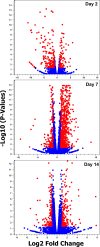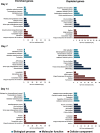Global Transcriptome Analysis of Aedes aegypti Mosquitoes in Response to Zika Virus Infection
- PMID: 29202041
- PMCID: PMC5700376
- DOI: 10.1128/mSphere.00456-17
Global Transcriptome Analysis of Aedes aegypti Mosquitoes in Response to Zika Virus Infection
Abstract
Zika virus (ZIKV) of the Flaviviridae family is a recently emerged mosquito-borne virus that has been implicated in the surge of the number of microcephaly instances in South America. The recent rapid spread of the virus led to its declaration as a global health emergency by the World Health Organization. The virus is transmitted mainly by the mosquito Aedes aegypti, which is also the vector of dengue virus; however, little is known about the interactions of the virus with the mosquito vector. In this study, we investigated the transcriptome profiles of whole A. aegypti mosquitoes in response to ZIKV infection at 2, 7, and 14 days postinfection using transcriptome sequencing. Results showed changes in the abundance of a large number of transcripts at each time point following infection, with 18 transcripts commonly changed among the three time points. Gene ontology analysis revealed that most of the altered genes are involved in metabolic processes, cellular processes, and proteolysis. In addition, 486 long intergenic noncoding RNAs that were altered upon ZIKV infection were identified. Further, we found changes of a number of potential mRNA target genes correlating with those of altered host microRNAs. The outcomes provide a basic understanding of A. aegypti responses to ZIKV and help to determine host factors involved in replication or mosquito host antiviral response against the virus. IMPORTANCE Vector-borne viruses pose great risks to human health. Zika virus has recently emerged as a global threat, rapidly expanding its distribution. Understanding the interactions of the virus with mosquito vectors at the molecular level is vital for devising new approaches in inhibiting virus transmission. In this study, we embarked on analyzing the transcriptional response of Aedes aegypti mosquitoes to Zika virus infection. Results showed large changes in both coding and long noncoding RNAs. Analysis of these genes showed similarities with other flaviviruses, including dengue virus, which is transmitted by the same mosquito vector. The outcomes provide a global picture of changes in the mosquito vector in response to Zika virus infection.
Keywords: Aedes aegypti; RNA-Seq; Zika virus; behavior; long noncoding RNA; microRNA; odorant binding protein; transcriptome.
Figures






Similar articles
-
Zika Virus Subgenomic Flavivirus RNA Generation Requires Cooperativity between Duplicated RNA Structures That Are Essential for Productive Infection in Human Cells.J Virol. 2020 Aug 31;94(18):e00343-20. doi: 10.1128/JVI.00343-20. Print 2020 Aug 31. J Virol. 2020. PMID: 32581095 Free PMC article.
-
Zika virus alters the microRNA expression profile and elicits an RNAi response in Aedes aegypti mosquitoes.PLoS Negl Trop Dis. 2017 Jul 17;11(7):e0005760. doi: 10.1371/journal.pntd.0005760. eCollection 2017 Jul. PLoS Negl Trop Dis. 2017. PMID: 28715413 Free PMC article.
-
Juvenile Hormone-Sensitive Ribosomal Activity Enhances Viral Replication in Aedes aegypti.mSystems. 2021 Jun 29;6(3):e0119020. doi: 10.1128/mSystems.01190-20. Epub 2021 May 26. mSystems. 2021. PMID: 34061577 Free PMC article.
-
Zika Virus Mosquito Vectors: Competence, Biology, and Vector Control.J Infect Dis. 2017 Dec 16;216(suppl_10):S976-S990. doi: 10.1093/infdis/jix405. J Infect Dis. 2017. PMID: 29267910 Free PMC article. Review.
-
Zika virus vertical transmission in mosquitoes: A less understood mechanism.J Vector Borne Dis. 2022 Jan-Mar;59(1):37-44. doi: 10.4103/0972-9062.331411. J Vector Borne Dis. 2022. PMID: 35708402 Review.
Cited by
-
How to turn an organism into a model organism in 10 'easy' steps.J Exp Biol. 2020 Feb 7;223(Pt Suppl 1):jeb218198. doi: 10.1242/jeb.218198. J Exp Biol. 2020. PMID: 32034051 Free PMC article. Review.
-
Differing Transcriptomic Responses in High Titer versus Low Titer Aedes aegypti Mosquitoes after Oral Infection with Sindbis Virus.Viruses. 2024 Sep 19;16(9):1487. doi: 10.3390/v16091487. Viruses. 2024. PMID: 39339963 Free PMC article.
-
Zika Virus Infection Produces a Reduction on Aedes aegypti Lifespan but No Effects on Mosquito Fecundity and Oviposition Success.Front Microbiol. 2018 Dec 18;9:3011. doi: 10.3389/fmicb.2018.03011. eCollection 2018. Front Microbiol. 2018. PMID: 30619118 Free PMC article.
-
Systematic identification and characterization of Aedes aegypti long noncoding RNAs (lncRNAs).Sci Rep. 2019 Aug 21;9(1):12147. doi: 10.1038/s41598-019-47506-9. Sci Rep. 2019. PMID: 31434910 Free PMC article.
-
Transcriptomic and small RNA response to Mayaro virus infection in Anopheles stephensi mosquitoes.PLoS Negl Trop Dis. 2022 Jun 28;16(6):e0010507. doi: 10.1371/journal.pntd.0010507. eCollection 2022 Jun. PLoS Negl Trop Dis. 2022. PMID: 35763539 Free PMC article.
References
Grants and funding
LinkOut - more resources
Full Text Sources
Other Literature Sources
Molecular Biology Databases
